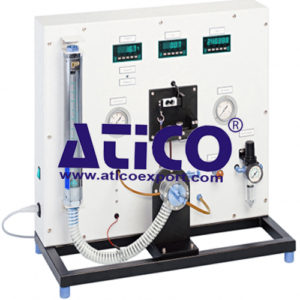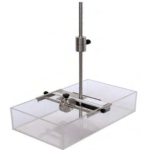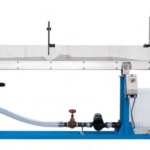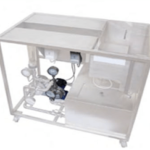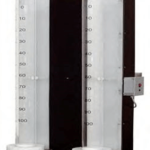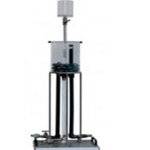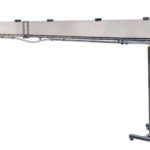In reaction turbines, the static pressure of the working medium in front of the rotor is higher than that behind it. In pure reaction turbines with a degree of reaction of one, the entire pressure energy in the rotor is converted to kinetic energy. This compressed-air driven experimental unit can be used to understand turbines powered by steam or water.
It is a single-stage, pure reaction turbine with a horizontal shaft. The rotor of the turbine has four outlet nozzles and is installed in a transparent housing. The air flows radially through the rotor and expands and accelerates as it exits through the outlet nozzles. The exiting air flow drives the turbine rotor according to the reaction principle. A band brake is used to apply a load to the turbine.
Learning Objectives & Experiments
- Familiarisation with the design and function of an impulse turbine
- Determination of torque, power and efficiency
- Graphical representation of characteristic curves for torque, power and efficiency
Specification
- Investigation of a compressed air driven radial reaction turbine
- Transparent housing for observing the operating area
- Rotor with 4 outlet nozzles
- Application of load to the turbine by means of a band brake
- Setting of the primary pressure with the pressure reducing valve
- Valve and flow meter for setting the flow
- Solenoid valve as a safety device to prevent overspeed
- Determination of the torque on the turbine shaft using a force sensor
- Measurement of the turbine speed with an optical speed sensor
- Manometer for displaying the pressure on the inlet and outlet side
- Digital display of speed, torque and temperature
Technical Specification
- Reaction turbine
- Max. Power: 20W at 19000min-1
- Rotor
- Diameter: 55mm
- 4 outlet nozzles, diameter: 1,5mm
- Measuring ranges
- Temperature: -20…1100°C
- Speed: 0…30000min-1
- Torque: 0…10Ncm
- Flow rate: 25…315L/min
- Inlet pressure: 0…2,5bar
- Outlet pressure: 0…0,1bar
- Primary pressure: 0…10bar
- 230V, 50Hz, 1 phase
- 120V, 60Hz, 1 phase

